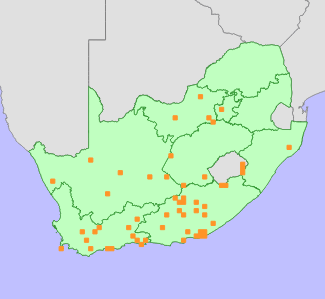| Scientific Name | Chenopodium mucronatum Thunb. | Higher Classification | Dicotyledons | Family | AMARANTHACEAE | Synonyms | Chenopodium vulvaria L., Chenopodium vulvaria of other authors, not of L., Range (misapplied name) |
National Status | Status and Criteria | Least Concern | Assessment Date | 2020/02/18 | Assessor(s) | L. von Staden | Justification | Chenopodium mucronatum is widespread and not in danger of extinction. |
Distribution | Endemism | Not endemic to South Africa | Provincial distribution | Eastern Cape, Free State, Gauteng, KwaZulu-Natal, Limpopo, Mpumalanga, Northern Cape, North West, Western Cape | Range | This species is widely distributed across South Africa, extending throughout eastern and Tropical Africa to Europe and the far East. It has been introduced to many other countries outside its native range. |
Habitat and Ecology | Major system | Terrestrial | Major habitats | Cape Seashore Vegetation, Central Ruens Shale Renosterveld, Breede Alluvium Renosterveld, Southern Coastal Forest, Southern Afrotemperate Forest, South Outeniqua Sandstone Fynbos, Suurberg Quartzite Fynbos, Suurberg Shale Fynbos, Hangklip Sand Fynbos, Breede Alluvium Fynbos, Muscadel Riviere, Albany Mesic Thicket, Namaqualand Riviere, Blombos Strandveld, Albany Alluvial Vegetation, Cape Lowland Alluvial Vegetation, Sundays Valley Thicket, Kasouga Dune Thicket, Hartenbos Dune Thicket, Grahamstown Grassland Thicket, Gamka Arid Thicket, Fish Valley Thicket, Escarpment Arid Thicket, Buffels Valley Thicket, Southern Karoo Riviere, Bushmanland Basin Shrubland, Zululand Lowveld, Kimberley Thornveld, Stella Bushveld, Gold Reef Mountain Bushveld, Dwarsberg-Swartruggens Mountain Bushveld, Koedoesberge-Moordenaars Karoo, Namaqualand Blomveld, Eastern Upper Karoo, Upper Karoo Hardeveld, Western Upper Karoo, Matjiesfontein Shale Renosterveld, Gamka Karoo, Breede Shale Renosterveld, Bushmanland Arid Grassland, Tarkastad Montane Shrubland, Queenstown Thornveld, Rand Highveld Grassland, Egoli Granite Grassland, Besemkaree Koppies Shrubland, Aliwal North Dry Grassland, Karoo Escarpment Grassland, Lesotho Highland Basalt Grassland, uKhahlamba Basalt Grassland, Bhisho Thornveld, Eastern Lower Karoo | Description | It occurs in a wide variety of habitats, but most often as a pioneer in disturbed places. |
Population | This is a widespread and common weedy species.
| Population trend | Stable |
Assessment History |
Taxon assessed |
Status and Criteria |
Citation/Red List version | | Chenopodium mucronatum Thunb. | Least Concern | Raimondo et al. (2009) | |
Bibliography | Brenan, J.P.M. 1988. Chenopodiaceae. In: E. Launert (ed). Flora Zambesiaca 9 (Part 1):133-161. Flora Zambesiaca Managing Committee, London.
Raimondo, D., von Staden, L., Foden, W., Victor, J.E., Helme, N.A., Turner, R.C., Kamundi, D.A. and Manyama, P.A. 2009. Red List of South African Plants. Strelitzia 25. South African National Biodiversity Institute, Pretoria.
Snijman, D.A. 2013. Plants of the Greater Cape Floristic Region 2: The extra Cape flora. Strelitzia 30. South African National Biodiversity Institute, Pretoria.
Wright, C.H. 1901. Chenopodiaceae. In: W.T. Thiselton-Dyer (ed). Flora Capensis V Section I (Acanthaceae-Proteaceae):433-454. Lovell Reeve & Co., Ltd., London.
|
Citation | | von Staden, L. 2020. Chenopodium mucronatum Thunb. National Assessment: Red List of South African Plants version 2024.1. Accessed on 2025/10/15 |
 Comment on this assessment Comment on this assessment
|
Search for images of Chenopodium mucronatum on iNaturalist
|
 Comment on this assessment
Comment on this assessment


